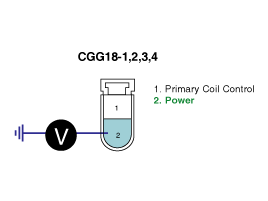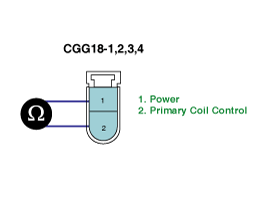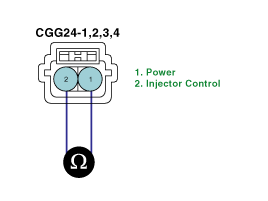Read "DTC Status" parameter.


Misfires can be caused by lack of combustion in a cylinder due to absence of spark, poor fuel metering, poor compression, or many other causes. Even a small number of misfires may result in excessive exhaust emissions due to the unburned mixture. Increased misfire rates cause damage to the catalytic converter. The PCM monitors the crankshaft speed variation to determine if any misfiring generated. The PCM identifies the specific cylinder in which the misfire has occurred and counts individual misfire events by monitoring changes in the crankshaft rotation for each cylinder. A random misfire indicates one or more cylinders are misfiring.
If a misfire exists that exceeds the threshold value, P0300 is set.
Item | Detecting Condition | Possible Cause | |
DTC Strategy | ● Engine roughness through crankshaft speed fluctuation | ● Poor connection ● Ignition system ● Fuel system ● Intake/exhaust air system ● Ignition timing ● Injector | |
Enable Conditions | ● Time after engine start > 25sec ● No error on CKPS. ● Eng. load change ≤ 41.2∼200 %/cycle ● Eng. speed change ≤2105∼4839 rpm/s ● No fuel-cut condition ● Not in hard driving condition ( >25sec ) | ||
Case1 | Enable Conditions | ● Engine speed 400∼6000 rpm | |
Threshold Value | ● Misfire rate > 2.5% per 1000 rev. | ||
Diagnostic Time | ● Continuous | ||
MIL ON Condition | ● 2 driving cycle | ||
Case2 | Threshold Value | ● Misfire rate >2.5~22.2% per 200 rev. (Depends on driving conditions) | |
Diagnostic Time | ● Continuous | ||
MIL ON Condition | ● Immediately (Blink) | ||
Ignition Coil Resistance (Primary) |
0.75 ± 15% at 20℃ (68℉) |
Connect scantool to Data Link Connector(DLC).
IG "ON".
Select "Diagnostic Trouble Codes(DTCs)" mode, and then Press F4(DTAL) to check DTC'sinformation from the DTCs menu
Confirm that "DTC Readiness Flag" indicates "Complete". If not, drive the vehicle within conditionsnoted in the freeze frame data or enable conditions noted in the DTC detecting condition.
Read "DTC Status" parameter.

Is parameter displayed "History(Not Present) fault"?
History fault : DTC occurred but has been cleared.
Present fault : DTC is occurring at present time.

▶ Fault is intermittent caused by poor contact in the sensor’s and/or ECM’s connector or wasrepaired and ECM memory was not cleared. Thoroughly check connectors for looseness,poor connection, bending, corrosion, contamination, deterioration, or damage.Repair or replace as necessary and then go to "Verification of Vehicle Repair" procedure.

▶ Go to "Terminal & Connector Inspection" procedure
Many malfunctions in the electrical system are caused by poor harness and terminals. Faults can also be caused by interference from other electrical systems, and mechanical or chemical damage.
Thoroughly check connectors for looseness, poor connection, bending, corrosion, contamination, deterioration, or damage.
Has a problem been found?

▶ Repair as necessary and go to "Verification of vehicle Repair" procedure.

▶ Go to "System inspection" procedure.
Spark plug check.
Remove cylinder’s spark plugs.
Visually/physically inspect the following items:
Damaged insulation, Worn electrodes, Oil or fuel fouled, Loose terminals and cracks
Check for plug gap : 1.0 - 1.1 mm (0.039 - 0.043 in.)
Check if the spark plug for the relevant cylinder is lighter in color than the other plugs.
Has a problem been found in any of the above areas?

▶ Repair or replace as necessary and go to "Verification of Vehicle Repair" procedure

▶ Go to "Compression pressure check" procedure.
Compression pressure check.
Warm up the engine to normal operating temperature.
Disconnect the spark plug cables. And remove the spark plugs and fuel pump relay.
Crank the engine to remove any foreign material in the cylinders.
Put compression pressure gauge into spark pulg hole.
Check compression pressure at each cylinder.
Specification : Approx. 15 kg/cm²
Is compression pressure for each cylinder displayed within specifications?

▶ Go to "Ignition system check" procedure.

▶ Add a small amount of oil through the spark plug hole, and repeat above steps.
▶ If the addition of oil causes the compression to rise, the cause is a worn or damaged piston ring or cylinder inner surface.
▶ If the compression remains the same, the cause is a burnt or defective valve seat, or pressure is leaking from the gasket.
▶ Repair as necessary and go to "Verification of Vehicle Repair" procedure.
Ignition system check
Key "OFF".
Disconnect Ignition coil connector.
Do visual inspection.
▶ Check contamination or damege on ignition coil.
Key "ON".
Measure the voltage between terminal 2 of ignition coil #1, #2, #3, #4 harness connectorand chassis ground.
Specification : Approx. B+

Is the measured voltage within specifications?

▶ Go to "Ignition coil check" procedure.

▶ Repair Open or Short to ground in power circuit, and go to "Verification of Vehicle Repair" procedure.
Ignition coil check
Measure the resistance between terminal 1 and 2 of ingnition coil connector #1, #2, #3, #4.
(Component side / Primary coil)
Ignition Coil Resistance (Primary) |
0.75 ± 15% at 20℃ (68℉) |

Is the measured resistance within specifications?

▶Go to "Timing mark check" procedure.

▶ Substitute with a known - good ignition coil and check for proper operation.
▶ If the problem is corrected, replace ignition coil and go to "Verification of Vehicle Repair" procedure.
Timing mark check.
Key "OFF".
Check the timing mark.
Is the timing mark normal?

▶ Go to "Air leakage check" procedure.

▶ Repair and go to "Verification of Vehicle Repair" procedure.
Air leakage check.
Visually/physically inspect the air leakage in intake/exhaust system as following items,
Vacuum hoses for splits, kinks and improper connections.
Throttle body gasket
Gasket between intake manifold and cylinder head
Seals between intake manifold and fuel injectors
Exhaust system between HO2S and Three way catalyst for air leakage.
Has a problem been found in any of the above areas?

▶ Repair or replace as necessary and go to "Verification of Vehicle Repair" procedure.

▶ Go to "PCV(Positive Crankcase Ventilation) valve check" procedure.
PCV(Positive Crankcase Ventilation) valve check.
Key "OFF".
Disconnect PCV valve.
Check the movement of plunger by putting in and out a thin stick.
Is the movement of plunger normal?

▶ Go to "Injector check" procedure.

▶ Substitute with a known - good PCV valve and check for proper operation.
▶ If the problem is corrected, replace PCV valve and go to "Verification of Vehicle Repair" procedure.
Injector check.
Key "OFF".
Remove injectors.
Check leakage or clog on injectors.
Measure the resistance between terminal 1 and 2. (Component side)
Temperature [℃(℉)] | Resistance (Ω) |
20 (68) | 13.8 ~ 15.2 |

Is the measured resistance within specification?

▶ Go to "Fuel line check" procedure.

▶ Substitute with a known - good injector and check for proper operation.
▶ If the problem is corrected, replace injector and go to "Verification of Vehicle Repair" procedure.
Fuel line check.
Check clog, contamination and damage on fuel line.
Splits, kinks and improper connections of fuel line pipe.
Interference, damage and improper connections of vacuum hose on fuel line.
Improper connection of connectors on fuel line.
Is the fuel line normal?

▶ Go to "Fuel pressure check" procedure.

▶ Repair as necessary and go to "Verification of Vehicle Repair" procedure.
Fuel pressure check.
Key "OFF".
Disconnect a fuel pump relay.
Engine start and wait until engine stop. and then key "OFF".
Install fuel pump relay.
Start the engine , and record fuel pressure.
Connect fuel pressure guage using the correct adaptor.
Specification : Approx. 3.5 kg/cm²

Is the fuel pressure normal?

▶ Many malfunctions in the electrical system are caused by poor harness(es) and terminals. Faults can also be caused by interference from other electrical systems, and mechanical or chemical damage. So, check poor connections and the related circuit between ECM and component thoroughly. Repair as necessary and go to "Verification of Vehicle Repair" procedure.

▶ Check clogging on the fuel filter.
▶ Check the fuel supply and return line.
▶ Repair as necessary and go to "Verification of vehicle Repair" procedure.
After a repair, it is essential to verify that the fault has been corrected.
Connect scan tool and select "Diagnostic Trouble Codes(DTCs)" mode.
Press F4(DTAL) and confirm that "DTC Readiness Flag" indicates "Complete".
If not, drive the vehicle within conditions noted in the freeze frame data or enable conditions.
Read "DTC Status" parameter.
Is parameter displayed "History(Not Present) fault"?

▶ System performing to specification at this time. Clear the DTC.

▶ Go to the applicable troubleshooting procedure.